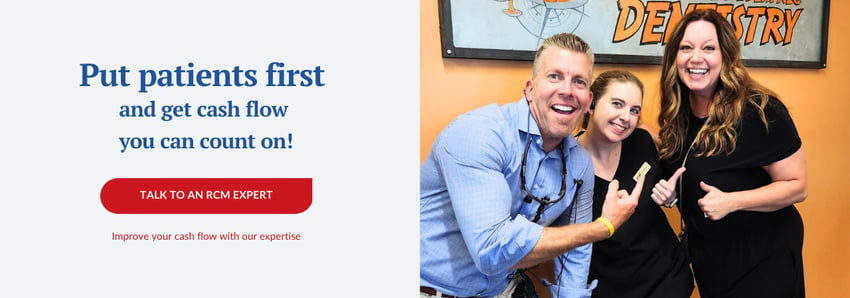Monthly reconciliation for dental insurance claims: 3 tips


To run a successful dental practice, it’s important to make sure that incoming payments match bank statements. That’s reconciliation, and it’s a best practice to make sure your money goes where it should. To make monthly reconciliation fast and easy, your dental insurance billing process needs to be organized.
And when it comes to payments you receive from insurance companies, the process can become monster-sized. You need a fast, accurate way to validate that what’s posted in your software matches deposits to your bank account.
There are different payment types, write-offs, and adjustments to consider. It’s a lot to keep up with.
Monthly reconciliation of your insurance payments is the best way to ensure money isn’t going into the wrong account – which has happened! But how do you perform monthly reconciliation successfully?
Dental ClaimSupport has been helping offices keep their insurance claim payments organized for over 10 years. We’ve spent these years learning the best practices for monthly insurance billing reconciliation, and what steps you can take to remain organized.
In this article, you will learn what is involved in the monthly reconciliation of insurance claim payments, and a few tips on how to reconcile successfully.
Understanding the “why” and “how” of monthly reconciliation can help your team not only stay organized when it comes to your stream of revenue. It will also help your team spot trends and get a fuller picture of where the dental practice stands financially.
What is involved in monthly insurance reconciliation at dental practices?
A lot of dental professionals refer to monthly reconciliation as the end-of-month close-out. It refers to every payment that has been posted with every provider and production code procedure. It also includes any adjustments that have been made and any write-offs for insurance companies.
This monthly report will include the gross production number, as well as the net production numbers (after any adjustments). Everything in monthly reconciliation is going to let you know how your practice has done for the month, financially.
So when we talk about reconciliation, we're typically talking about insurance collections reconciliation, since that is typically the largest amount for practices.
You look at each insurance provider's production, adjustments, write-offs, and then their collections, adjustments to collections, and then their final collections, which are called net collections. You’ll also look at the outstanding insurance claims report to see what has not been collected.
When you look at those gross and net numbers, you have to be sure they make sense. This means payments match what’s actually deposited into your bank account for the month.
Now let’s get into some best practices for monthly reconciliation at a dental practice.
.jpg?width=603&name=DSC00906%20(1).jpg)
Tip #1: Reconcile at the end of each day to make monthly reconciliation easier.
It's important to have a daily reconciliation so that your monthly reconciliation will be easier to perform.
Most practices run a day sheet or a daily deposit report. It will list your gross production, adjustments, your write-offs for insurance, and your net production. Same as a monthly reconciliation, except it’s a snapshot of that day, not the entire month.
When you do this every day, it’s easier at the end of the month to pull up these reports and compile them.
Balance your numbers every day
If you're balancing on a daily basis, then by the end of the month, all you have to do is run your reports using a larger date range. Most practice management software makes this pretty easy for you.
For example, if it's June 1 through June 30, or whatever date range you're running, you'll enter that date range. That gives you grand totals for that month.
Each day makes up those totals. There are some differences with each software, though. But in each, you should be able to find a report that gives you your gross and net production, your adjustments as your discounts, and your insurance write-offs.
Tip #2: Have more than one team member handling monthly reconciliation.
We highly recommend the person who is actually posting the payments should not be the same person who balances these payments in the practice’s bank account. When dealing with money and numbers, it’s smart to have a second set of eyes.
Numerical errors can create a lot of extra work for whoever has to balance the accounts. And when just one person is staring at the financial reports all day in addition to the bank statements, it’s easy to get numbers mixed up. Lessen the errors with monthly reconciliation by having at least two people handling it.
Unfortunately, there is another reason to have more than one person handling reconciliation: embezzlement prevention.
Prevent embezzlement at the dental office
It happens more often than you think. In 2019, an ADA survey revealed that 49% of dentists they polled had directly experienced embezzlement.
When the person who handles your insurance payment postings is looking through all of these numbers alone, it creates a bigger opportunity for embezzlement to occur. The reason they can move money around so easily is that there is not anyone overseeing their work.
So two team members split up the task of posting payments and balancing the payments with what is in the bank account to lessen the risk.

Tip #3: Keep all of your financial records in one organized place.
Staying organized is key when doing any kind of reconciliation. Consider using two monitors when posting. It will speed up your process as you can have your EOBs and EFTs on one monitor and your patient insurance payments on the other.
If you notice errors in your reports - still keep that organizational mindset. Never edit transactions or delete transactions from the past. This is improper bookkeeping and confuses the patients, staff, and owner.
It also raises red flags to the accountants and tax or insurance auditors. Check your practice management software security settings by user permissions. Post adjustments to offset errors and document each adjustment as to why it was made.
You can also stay organized by attaching a copy of your bank deposit slip to the bank deposit receipt to your daily reports. Include your credit card batch report as well and make sure all deposits match your software deposit report. This method makes it much easier to enter your deposits into your separate accounting software.
Scan, import and save all of your EOBs/EFT/ERAs in one folder on your secure shared network drive (not a desktop). Consider having a folder for each year, with subfolders for each month and then each day in the month. They’ll be saved by the date posted.
This is the fastest way to post and bring up an EOB if needed. Be sure that your backup system includes this folder!
Understand your specific practice management software’s reporting system
Dental teams should understand their individual practice management software requirements. Some software programs require a final day sheet or monthly close out.
And when we say require, don't worry - alarms don't go off if you don’t do it. But what happens is your software won't necessarily keep your numbers updated and your reports could be inaccurate.
For example, with Eaglesoft, you have an end-of-month close-out to mark your month as complete.
Every software has its own nuances on how the end-of-month reconciliation should be done and how the daily reconciliation is done. So it's always best to check with your practice management software for specifics on what to do.
Ready to successfully report on your dental practice revenue?
Reconciling at the end of each month can help your team see how your practice is performing. This monthly task can be done most easily when you run daily reconciliation. Plus you’ll catch and fix more discrepancies by having more than one team member handling the reconciliation, and you’ll keep everything organized within your practice management software.
You now have the tips you need to successfully conduct your dental practice’s monthly insurance billing reconciliation. But if lack of time is causing stress for you, Dental ClaimSupport is a great resource for dental teams. Daily posting and deposit detail match and reconciliations are part of the billing services Dental ClaimSupport customers receive - have a look.
Learn more about how to post and reconcile payments in this on-demand training course (and earn CE credit).
Related Posts
Dental revenue resources from Dental Claim Support

